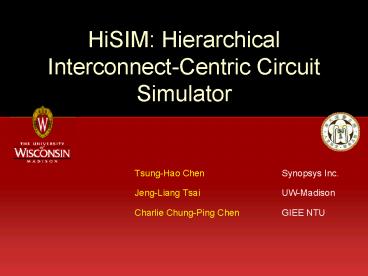HiSIM: Hierarchical InterconnectCentric Circuit Simulator - PowerPoint PPT Presentation
1 / 14
Title:
HiSIM: Hierarchical InterconnectCentric Circuit Simulator
Description:
Preconditioned iterative methods for power-grid analysis. Substrate/power-grid co-analysis ... Decreasing supply voltage (smaller noise margin budget) ... – PowerPoint PPT presentation
Number of Views:36
Avg rating:3.0/5.0
Title: HiSIM: Hierarchical InterconnectCentric Circuit Simulator
1
HiSIM Hierarchical InterconnectCentric Circuit
Simulator
- Tsung-Hao Chen Synopsys Inc.
- Jeng-Liang Tsai UW-Madison
- Charlie Chung-Ping Chen GIEE NTU
2
Outline
- Introduction
- Reluctance extraction and simulation
- Preconditioned iterative methods for power-grid
analysis - Substrate/power-grid co-analysis
- Reluctance-enhanced model order reduction
- Interconnect-centric nonlinear circuit simulation
- Macro-modeling technique and hierarchical
analysis - Partitioned explicit method
- Summary
3
Motivation
- Power delivery noises (IR drop, Ldi/dt drop) are
getting significant - Increasing power(current) consumption
- Decreasing supply voltage (smaller noise margin
budget) - Need to perform signal/power integrity analysis
- Interconnect-centric large of linear elements
4
Signal/Power Integrity Analysis Issues
- Signal/power integrity problems are analog
- Switch-level analysis may not be satisfactory
- SPICE-level accuracy simulation is required
- Large-scale, or chip-level simulation is needed
- Size matters
- Millions-billions of passive and active devices
- SPICE simulation is slow and memory inefficient
- SPICE3 DC analysis (nodegt10,000) several hours
- How about node gt millions?
- Efficient and accurate chip-level
interconnect-centric analysis methods are
important.
5
Power-delivery Noises Cause Timing Uncertainty
- Timing is important for some circuits
- Clock skew uncertainty caused by IR-drop
- I/O pad timing uncertainty from simultaneous
switching
Clock simulation with dynamic IR-drop R. Saleh,
et al, 2000
6
Timing Also Induces Noises
- Timing also induces power fluctuation noises
- Drivers are nonlinear
- Decoupled linear/nonlinear methods lose timing
information - Need
- efficient and accurate
- interconnect-centric
- nonlinear circuit simulation
- methods
Source Intel Journal
7
Interconnect-Centric Circuit Analysis
- Timing information are important for some
applications - Need to include nonlinear device models
- e.g. clock-tree and power-grid co-analysis
- Interconnect centric
8
Computation Cost of Nonlinear Simulation
- Nonlinear simulation
- performs Newton-Raphson for each time-step
- each NR iteration has to LU once
- Runtime ? of NR iterations ? cost of LU
- Reduce the cost of LU
- Flat analysis does LU to the whole system
(linear nonlinear) - Objective circuit contains largenumber of linear
elements - Only nonlinear elements change for each NR
iteration - Temporal latency
Transient simulation flow
Newton-Raphson
9
Macromodeling and Hierarchical Analysis
- Build macromodels for all sub-circuits
- Combine macromodels and form a smaller system
- Only build macromodels for linear sub-circuits
once - No need to rebuild nonlinear macromodels if port
voltage doesnt change
10
Realization in Matrix
- Macromodeling by LU(or Cholesky) decomposition
- Combine macromodels and form a smaller matrix
11
Runtime Comparison
- Benefit from temporal latency
12
Concept of Partitioned Explicit Method
- Explicit predictor and iterative corrector
- Original NR LU(AB)
- New method LU(A)
- We prove the convergence condition.
- Simulation result shows 2-3 steps to converge
i
i
Nonlinear, A
Nonlinear, A
After correction
Linearization Ai
xi1
xi1
Linear prediction
xi
xi
Linear, B
Linear, B
Linearization Ai
v
v
ith iteration of NR
Predictor and corrector
13
Realization Partitioned Explicit Method
- Partition circuit into linear and nonlinear parts
- Phase 1 Fix the port current
- Phase 2 Fix the port voltage
Original system
Partitioned explicit method
14
Runtime Comparison
- Clock-tree and power-grid co-analysis
- 180x faster than flat simulation
15
Backup Slides
16
Computation Cost Reduction
- Flat analysis
- has to perform LU for the whole matrix in every
NR iteration. - Hierarchical analysis
- Linear sub-circuits
- only has to perform LU once, and
- reuse macro-models in every NR iteration
- Nonlinear sub-circuits
- check port voltages
- Reuse macro-models if no changes
- Benefit from temporal latency































